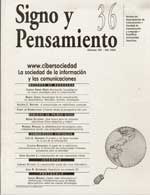Abstract
En este artículo, el autor construye analogías entre el desarrollo de los virus informáticos y el desarrollo del virus del Síndrome de Inmunodeficiencia Adquirida - SIDA - desde la perspectiva de la construcción social de la realidad por los medios de comunicación. Se afirma que hay tendencias científicas que exploran el problema de los cada vez más difusos límites entre la vida real y vida artificial. Se construyen analogías entre ambos virus a partir del análisis de percepcioes colectivas frente al mal, a lo invisible, a los destructor y a la auto-reproducción. El autor analiza la historia de los virus informáticos desde 1970 y propone una definición de virus informático. Se describen los distintos tipos de virus y sus características. El problema de las vacunas y la prevención del virus es abordado. Se define al ciberespacio como un nuevo espacio de construcción social de la realidad (o hiper-realidad).This journal is registered under a Creative Commons Attribution 4.0 International Public License. Thus, this work may be reproduced, distributed, and publicly shared in digital format, as long as the names of the authors and Pontificia Universidad Javeriana are acknowledged. Others are allowed to quote, adapt, transform, auto-archive, republish, and create based on this material, for any purpose (even commercial ones), provided the authorship is duly acknowledged, a link to the original work is provided, and it is specified if changes have been made. Pontificia Universidad Javeriana does not hold the rights of published works and the authors are solely responsible for the contents of their works; they keep the moral, intellectual, privacy, and publicity rights.
Approving the intervention of the work (review, copy-editing, translation, layout) and the following outreach, are granted through an use license and not through an assignment of rights. This means the journal and Pontificia Universidad Javeriana cannot be held responsible for any ethical malpractice by the authors. As a consequence of the protection granted by the use license, the journal is not required to publish recantations or modify information already published, unless the errata stems from the editorial management process. Publishing contents in this journal does not generate royalties for contributors.


